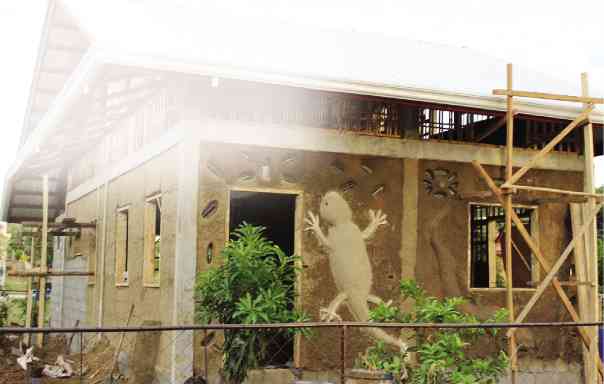Climate change revives ‘natural building’ of houses

FILMMAKER Christopher Gozum is building his very own cob house (photo below) which should survive a changing climate in Pangasinan’s Bayambang town. CONTRIBUTED PHOTOS
In a corner of a subdivision in the agricultural town of Bayambang, a “mud” or “cob” house is rising. It is not a playhouse. It is a three-bedroom bungalow that independent filmmaker Christopher Gozum is building for his family. And the technology he is using is as old as time, Gozum says.
The 60-square-meter house is made of sustainable materials like bamboo, river stones, coconut lumber and cob (a mixture of soil, water and hay), sawdust and lime.
“This is a cob house. We are using materials that are abundant and readily available in the locality,” he says of the rising structure which looks incongruous in a neighborhood where houses have contemporary architectural designs.
And because of climate change, the technology is being revived by environmental activists and sustainable architecture advocates who want to go back to “natural building,” Gozum says.
Article continues after this advertisementAside from being inexpensive, cob houses are healthy because they are made of natural materials, Gozum says. They also leave less carbon footprints because few materials that are industrially-produced like cement are used.
Article continues after this advertisementRegulating temperature
Cob also works as a thermostat of sorts, regulating the temperature inside the house. “When it is hot outside, it is cool inside. But when it is cold outside, it is warm inside,” Gozum says.
Building with earth materials has been long practiced in Pangasinan province, with most of its churches and old buildings made of bricks.
“But making bricks is not sustainable as you need plenty of wood, which means cutting down trees, to fire the bricks. With cob, you only need the sun for drying the mud and rice straw mixture,” Gozum says.
He hired three experts on cob building from Northern Luzon who, while working, teach local workers on the technology so they can later become the cob builders in the town.
Unlike the ancient cob houses which used cogon grass for roofing, Gozum decided to use galvanized iron sheets for practical reasons. He also used concrete posts instead of lumber to spare the trees that would have gone into the construction.
Gozum uses concrete and hollow blocks for the foundation and saves the earth materials (also from the septic tank) to be a component of the cob. The hollow blocks will later be covered with river stones for a natural appearance.
“Around 97 percent of the wall would be made of cob. Only the walls of the bathroom and the part of the kitchen, where the sink would be put, would be concreted,” he says.
During the Inquirer’s visit, the second week of construction, the house frame was already standing, with woven strips of bamboo and coconut lumber, which would serve as wall panels, already in place.
Some workers were busy with sifting the soil; others were mixing the earth, rice straws (which were soaked overnight) and water with their bare feet. Others were daubing the cob into the wattle.
“This is just the first daub,” a worker says. A finer cob will be daubed next, and finally, the eight-inch thick walls will be plastered with lime to protect the cob from the elements. A half-meter awning or extension of the roof will surround the house to keep rainwater at bay.
Serenity, good acoustic
The floor will be made of cob, too, and will be painted with acrylic which is water resistant, so the floors will not turn muddy, Gozum says.
For a filmmaker like him, Gozum says cobs offer good acoustic. “I would be using one room to edit my films, so I would need a room with good acoustic that the cob walls provide,” he says.
As a further pitch for cob houses, Gozum says one feels a kind of serenity inside which cannot be had with houses made of concrete.
“‘Cob’ is actually a very ancient technology. The cob houses in Europe and America managed to survive through the centuries and they now fetch substantial amount of money,” he says.
It seemed natural for this filmmaker to build a mud house. After all, he founded the independent film company Cine Caboloaan, which is “committed to producing films about Pangasinan and its people in the homeland and in the diaspora.”
His films included Anak Banwa (Child of the Sun), a story on Pangasinan and which used the local language, and Lawas kan Pinabli (Forever Loved), an experimental documentary on “darker side” of an overseas Filipino worker’s life in the Middle East.
Gozum’s passion for advocating the preservation and promotion of Pangasinan language and its culture extends to building for his family a house with mostly organic materials.
He calls the house “Abong na Ilalam” or house of imagination, and posts the construction activities on his Facebook account as he invites those interested to learn about cob, or mud, building, to come for a workshop.
Gozum’s post on Faceboook reads, “Learn how to build an inexpensive house using local and natural materials like mud, sand, bamboo, rice straw, cogon, boulder stones, lime and wine bottles. With your own hands and feet, and with your imagination and heart.”
The cob or mud house is the central element of the 200-square-meter homestead. It will also feature a solar energy system, a low-cost rainwater harvesting system, an inexpensive greenhouse-nursery with composting and vermi composting bins as well as storage area for fermented juices and indigenous micro-organisms, a low-cost aquaponics system, an inexpensive greywater (household wastewater with exception of wastewater from toilets) recycling system and a small cob oven.
